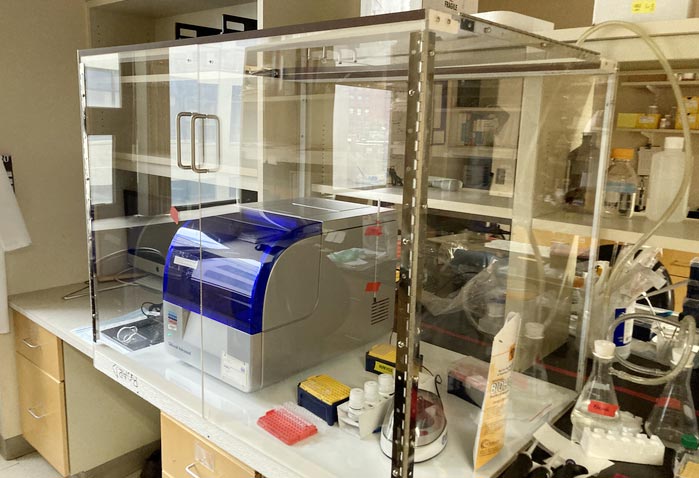Scientists develop an RNA-based breath test to detect COVID-19

Bubbler kits were processed in a negative pressure bench top box to prevent contamination of amplicon particles in the laboratory.
Credit: William G. Fairbrother
The Bubbler, a breathalyzer that reverse-transcribes RNA from airborne SARS-CoV-2 in breath, predicts lower respiratory tract involvement and is less invasive than alternative testing approaches, report researchers in The Journal of Molecular Diagnostics.
In a new study in The Journal of Molecular Diagnostics, published by Elsevier, investigators report on the design and testing of a breathalyzer, known as the Bubbler, that relies on viral RNA detection to diagnose SARS-CoV-2. Its name is derived from the bubbling sound that occurs when the patient exhales into the device.
The Bubbler not only reverse transcribes RNA from airborne virus particles into DNA to be tested via PCR but can also barcode that DNA, allowing samples to be linked directly to the patient they have come from and be used for sequencing. It can be used for simultaneous batches of pooled samples and provides additional information such as viral load and strain identity and eliminates the need for stabilizing a sample, potentially allowing the assay to be performed at home.
“Involvement of the lower respiratory tract is often a precursor to severe COVID-19, so there is an argument for a more direct sampling focused on exhaled breath,” explained lead investigator William G. Fairbrother, PhD, professor in the department of molecular biology, cell biology and biochemistry at Brown University in Providence, RI, USA.
Virus detection by the Bubbler is similar to a hospital-swab PCR test; however, it is a better measure of risk of contagion as it detects airborne viral particles. Swab tests can return a positive result for months after infection as they detect viral RNA fragments in cells that persist in previously infected cells. The Bubbler can also be adapted for environmental sampling in hospitals, transportation hubs, and closed environments like offices, ships, and planes, the investigators report.
Seventy patients treated in the Emergency Department of Rhode Island Hospital between May 2020 and January 2021 were screened. The study tested samples from three points in the respiratory tract. Tongue scrapes from the mouth (saliva/tongue scrapes) and from 15 seconds of exhaled breath collected in the Bubbler were compared to those from a conventional nasopharyngeal swab PCR test. The Bubbler is a glass tube with a glass pipette through which patients can exhale. The tube is filled with a reverse transcription reaction mixture and cold mineral oil.
The study determined that SARS-CoV-2 can be readily detected in the breath and is more predictive of lower respiratory tract involvement. Viral RNA is more enriched in the breath relative to oral samples, while oral samples include cells involved with SARS-CoV-2 replication that breath samples do not. This suggests the viral signal detected in the Bubbler comes from active viral particles.
“The Bubbler is more likely to be a better indicator of current infection than nasopharyngeal swabs,” said Dr. Fairbrother. “Another advantage is the barcoding, which enables high-throughput RNA virus testing at a fraction of the cost of conventional testing. The barcode returns a viral sequence that also supports strain identification, which may prove useful as more information is learned about transmissibility and possible strain-specific treatment decisions.”
The investigators also demonstrated how the Bubbler might be adapted to detect virus in airborne samples. To model the movement of droplets exhaled in human breath, three unique nucleic acid samples were added to three personal humidifiers at different locations at varied distances from the Bubbler in a room with high airflow and a room with low airflow. Although a detailed exploration of this application was beyond the scope of the study, the results demonstrate the potential to use aerosolized nucleic acids to quantitatively map airflow in indoor spaces, and to detect SARS-CoV-2 in the air.
“Such technology could be useful in restoring service to industries such as hotels, cruise ships, and casinos,” Dr. Fairbrother observed. “There is also an epidemiological benefit to routine testing of air at early warning sites such as transportation hubs and hospital emergency departments.”
Tests for COVID-19 usually use samples collected from the upper respiratory tract by saliva or nasopharyngeal swab. Positive samples contain active virus, but viral load in the upper respiratory tract is not correlated with symptoms in the lower respiratory tract, such as pneumonia.
Journal: Journal of Molecular Diagnostics
DOI: 10.1016/j.jmoldx.2021.09.005
Method of Research: Experimental study
Subject of Research: People
Article Title: Efficient Detection of Severe Acute Respiratory Syndrome Coronavirus 2 (SARS-CoV-2) from Exhaled Breath
All latest news from the category: Life Sciences and Chemistry
Articles and reports from the Life Sciences and chemistry area deal with applied and basic research into modern biology, chemistry and human medicine.
Valuable information can be found on a range of life sciences fields including bacteriology, biochemistry, bionics, bioinformatics, biophysics, biotechnology, genetics, geobotany, human biology, marine biology, microbiology, molecular biology, cellular biology, zoology, bioinorganic chemistry, microchemistry and environmental chemistry.
Newest articles

Innovative 3D printed scaffolds offer new hope for bone healing
Researchers at the Institute for Bioengineering of Catalonia have developed novel 3D printed PLA-CaP scaffolds that promote blood vessel formation, ensuring better healing and regeneration of bone tissue. Bone is…

The surprising role of gut infection in Alzheimer’s disease
ASU- and Banner Alzheimer’s Institute-led study implicates link between a common virus and the disease, which travels from the gut to the brain and may be a target for antiviral…

Molecular gardening: New enzymes discovered for protein modification pruning
How deubiquitinases USP53 and USP54 cleave long polyubiquitin chains and how the former is linked to liver disease in children. Deubiquitinases (DUBs) are enzymes used by cells to trim protein…



